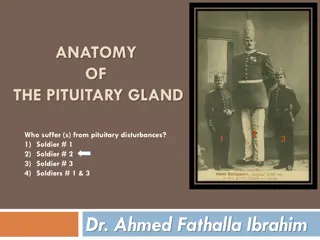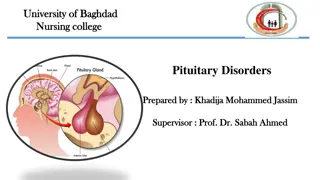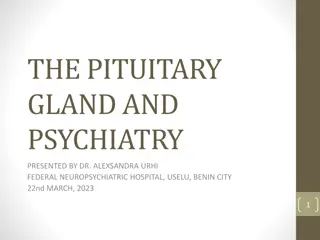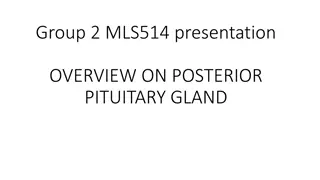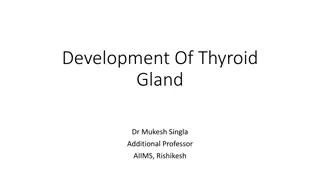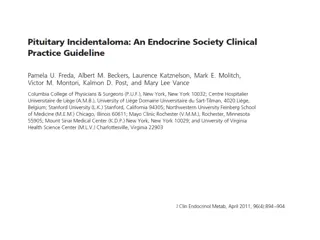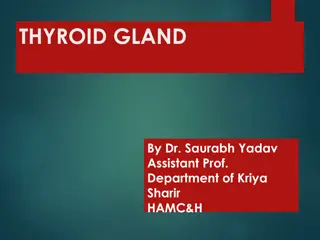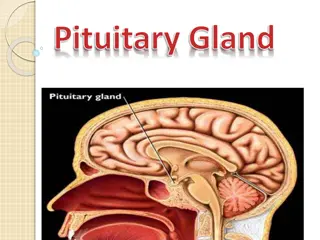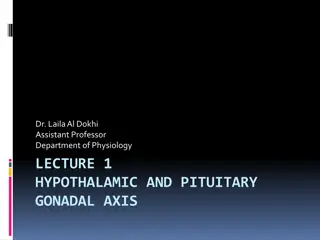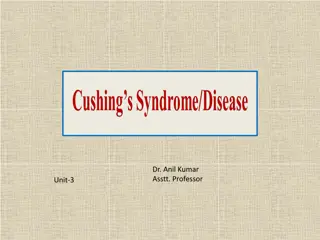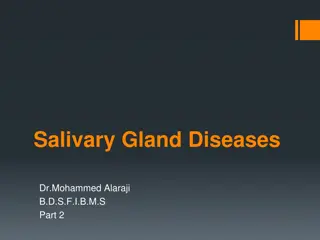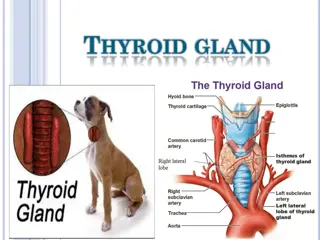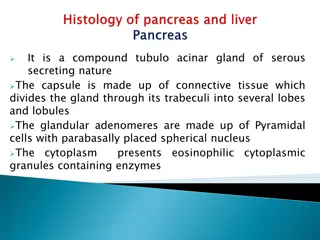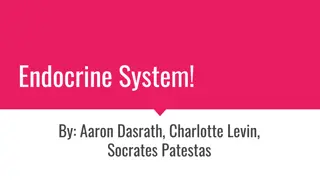Understanding the Microscopic Structure and Function of the Pituitary Gland
Explore the detailed histology of the pituitary gland, focusing on its adenohypophysis and neurohypophysis components. Learn about the diverse parenchymal cells, including acidophils, basophils, and chromophobes, and their respective functions in hormone production. Dive into the significance of the hypophyseal portal circulation and the storage and release mechanisms of vasopressin and oxytocin in the neurohypophysis. Test your knowledge with questions on cell types, capillaries, and anatomical locations related to the pituitary gland.
Uploaded on Sep 10, 2024 | 0 Views
Download Presentation

Please find below an Image/Link to download the presentation.
The content on the website is provided AS IS for your information and personal use only. It may not be sold, licensed, or shared on other websites without obtaining consent from the author. Download presentation by click this link. If you encounter any issues during the download, it is possible that the publisher has removed the file from their server.
E N D
Presentation Transcript
Pituitary gland Red: important. Black: in male|female slides. Gray: notes|extra. Editing file Editing file
OBJECTIVES o The microscopic structure of the different parts of the PITUITARY GLAND in correlation with their functions o The HYPOPHYSEAL PORTAL CIRCULATION; Components & significance Histology team 437 | Endocrine block | Lecture one
Components of pituitary gland: I- Adenohypophysis Cerebri 1- Pars Distalis (pars anterior): Types of parenchymal cells: o Chromophils: Acidophils: 1. Somatotrophs (GH cells).Growth hormone 2. Mammotrophs (Prolactin cells):Increase during lactation. Milk formation hormone Basophils: 1. Thyrotrophs (TSH Cells).Thyroid stimulated hormone 2. Corticotrophs (ACTH cells). Adrenocorticotropic hormone 3. Gonadotrophs (Gonadotropic cells) (FSH, LH). Luteinizing hormone (LH) Follicle Stimulating Hormones (FSH) Chromophobes, may represent: stem cells. degranulated chromophils. degenerated cells. o Blue arrow: acidophils Red arrow: basophils Yellow arrow: chromophobes 2- pars Tuberalis 3- Pars Intermedia Histology team 437 | Endocrine block | Lecture one
II- Neurohypophysis Cerebri 1- Median eminence 2- Infundibulum: Neural (Infundibular) Stalk (stem) 3- Pars Nervosa: Components: o Unmyelinated axons ofsecretory neurons situated in supraoptic & paraventricular nuclei (i.e. Axons of hypothalamohypophyseal tract) Function: Storage & release of: 1. Vasopressin (ADH); by supraoptic nuclei 2. Oxytocin; by paraventricular nuclei Oxytocin work in mammary gland for milk ejection (by contraction of myoepithelial cell that located around the acini) Fenestrated blood capillaries with diaphragm Herring bodies Are distentions of the axons in p. nervosa. Representing accumulation of neurosecretory granules at axon termini and along the length of the axons in p. nervosa. Oxytocin and ADH hormone is stored in Herring bodies o o Pitucytes: are glial-like cells in p. nervosa. Structure: Have numerous cytoplasmic processes. Functions: Support the axons of the p. nervosa. o N.B. No secretory or neuronal cells in pars nervosa Histology team 437 | Endocrine block | Lecture one
QUESTIONS: Q1: Which one of the following is Acidophils Chromophils? a) Thyrotrophs b) Somatotrophs c) Gonadotrophs d) Corticotrophs Q2: which of the following contains TSH cells ? a) Thyrotrophs b) Somatotrophs c) Gonadotrophs d) Corticotrophs 6- c 5- A Q3: Corticotrophs contains which cells ? a) ACTH cells. b) TSH cells. c) GH cells. d) Prolactin cells 4- B 3- A 2- A 1- B Q4: Which cells are present in pars nervosa? a) Secretory cells b) Glial-like cells c) Neuronal cells d) All of them Q5: The axons of hypothalamohypophyseal tract are situated in? a) Supraoptic nucleus b)Suprachiasmatic nucleus c) Dorsomedial nucleus d) Lateral preoptic nucleus Q6: Which of the following is the type of capillaries in pars nervosa? a) Continuous capillaries b)Discontinuous capillaries c) Fenestrated capillaries d) Non-fenestrated capillaries Histology team 437 | Endocrine block | Lecture one
Team members : Rinad Alghoraiby Ebtesam Almutairi Shahad Alzahrani Fahad Alnuhabi Tareq Allhaidan Abdulmalik Alharbi Team leaders : Khalid Fayez Alshehri Marwah Alkhalil Twitter.com/Histology437 HistologyTeam437@gmail.com


